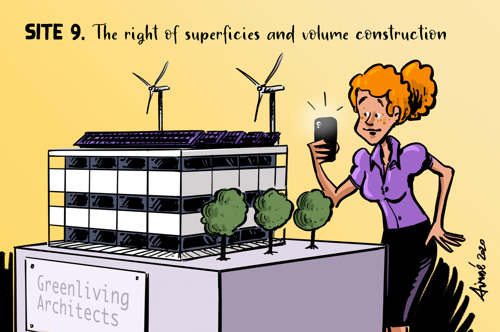- Real Estate, Renting and Co-ownership , Construction Law
- right of superficies , volume construction , long lease rights , removal of building rights
The new property law introduces two new elements within the concept of the right of superficies, that are related to the volume of the planned constructions and to the maximum duration of the right of superficies itself. In certain cases, it may be therefore more interesting to opt for a long lease right instead of a right of superficies. In this article you will find out why.
1. What does a right of superficies mean?
A right of superficies contains the right to erect and have buildings or plantings on someone else's land.
This means that one party (the leaseholder) is allowed to erect structures and plantings on the land of another party (the land owner), which at the end of the right of superficies becomes the property of the land owner by means of accession.
This concept is often used in the development of (residential) construction projects.

2. What is new?
2.1 The volume of the construction must be determined in advance
An additional element to the definition of a right to superficies is included in the new property law, the so called "volume".
From the moment the right of superficies is granted, the volume within which buildings or plants may be erected will have to be determined. This will not be so easy all the time, since it means that at the moment the right of superficies is set, there already has to be some clarity about this volume.
2.2 Duration
In addition to the limitation of the right of superficies to the contractually stipulated volume, the duration of the right of superficies is another important novelty.
Whereas today the duration is still limited to a maximum of 50 years, the right of superficies may be entered into for a maximum of 99 years. Once this period has expired, the right of superficies will be extinguished (see point 4 for the consequences).
Of course, a shorter term can be contractually agreed. It can be extended afterwards. However, when extending the initial term afterwards, the parties must take into account that the entire term may not exceed 99 years. Moreover, the extension must take place with the express agreement of the parties. Therefore, this must be explicitly stipulated contractually.
Contrary to the rule that a right of superficies can only be granted for a maximum period of 99 years, the right of superficies can also be perpetual in two cases:
1° either for the purposes of public domain ;
2° or to enable the division into volumes of a complex and heterogeneous property comprising different volumes that are eligible for independent and diverse use and that do not have any common part among themselves.
In short, if you wish to benefit from a perpetual right of superficies and it is not a project in relation to the public domain, it must be a "complex and heterogeneous property comprising different volumes", with an "independent and diverse use" and without any common parts.
3. When and how will a right of superficies extinguish?
The mere destruction of the buildings or plantings does not automatically result in the extinction of the right of superficies. The lease holder therefore retains his property use right in accordance with his title.
However, if the perpetual right of superficies has lost his efficiency - including future or potential - for at least 99 years, the court can order its removal.
The legislator does not regulate how an extinction of a perpetual right of superficies can take place in the case of a complex heterogeneous property.
Therefore, if restrictions on the (perpetual) right of superficies are required, the contract should determine these.
4. What are the consequences of the extinction of a right of superficies?
In case a right of superficies is extinguished, the ownership of the buildings and/or plantings erected by the building owner or lease holder is transferred to the land owner or his (meanwhile) legal successor.
The land owner will then have to pay a fee to the lease holder for the buildings and/or the plantings. Until the payment of this compensation, the lease holder retains a right of retention.
Of course, it is possible to make contractual arrangements on this matter.

5. Difference with long lease right (emphyteusis)
Under the new property law, the long lease right is defined as a right of use in rem conferring full use and enjoyment of someone else's property, which is immovable by its nature or by incorporation.
This definition corresponds to the long lease right as it is known today.
Parallel with the right of superficies, there is a possibility to provide for a perpetual long lease right, this for purposes of the public domain. Within this concept, however, there is no exception regarding the limitation in time for complex heterogeneous immovable properties.
As the long lease holder may also erect buildings or plantings, but, unlike the right of superficies, without limitation to the contractually stipulated volume, it may be in some cases more interesting to opt for a long lease right instead of a right of superficies.
It will therefore be important to make the right choice. As indicated earlier, one can already opt for the implementation of certain rules of the new property law in current contracts. These will of course only apply from its entry into force, i.e. 1 September 2021.
So, to find out which concept you prefer or to find out whether your project can be considered a heterogeneous complex, you can always contact the specialists of Seeds of Law on +32 (0)2 747 40 07 or via info@seeds.law.
This was our last stop on our road trip. We hope that this trip through the new property law was interesting and will be an added value for you and your future projects. We will always be available if you would like more information or assistance!
Read alsoDiscover our e-book about the new property law
In our e-book "Together on a roadtrip through the new property law" you will discover a number of important topics about the new property law.






